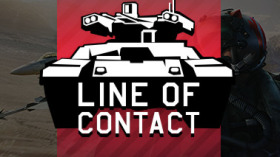
- Für PC
- Für MAC
- Für Linux
- Betriebssystem: Windows 10 (64bit)
- Prozessor: Dual-Core 2.2 GHz
- Arbeitsspeicher: 4GB
- DirectX 11 fähige Grafikkarte: AMD Radeon 77XX / NVIDIA GeForce GTX 660; die geringste Auflösung für das Spiel beträgt 720p
- Netzwerk: Breitband-Internetverbindung
- Festplatte: 21,5 GB (minimaler Client)
- Betriebssystem: Windows 10/11 (64bit)
- Prozessor: Intel Core i5 / Ryzen 5 3600 oder besser
- Arbeitsspeicher: 16 GB und mehr
- DirectX 11 fähige Grafikkarte oder höher mit den neuesten Treibern: NVIDIA GeForce GTX 1060 oder höher / AMD Radeon RX 570 oder höher
- Netzwerk: Breitband-Internetverbindung
- Festplatte: 60,2 GB (Full Client)
- Betriebssystem: Mac OS Big Sur 11.0 oder neuer
- Prozessor: Intel Core i5, 2.2 GHz (Intel Xeon Prozessoren werden nicht unterstützt)
- Arbeitsspeicher: 6 GB
- Grafikkarte: Intel Iris Pro 5200 oder analoge AMD / Nvidia für Mac. Die geringste Auflösung des Spiels beträgt 720p mit Metal Support
- Netzwerk: Breitband-Internetverbindung
- Festplatte: 21,5 GB (minimaler Client)
- Betriebssystem: Mac OS Big Sur 11.0 oder neuer
- Prozessor: Intel Core i7 (Intel Xeon Prozessoren werden nicht unterstützt)
- Arbeitsspeicher: 8 GB
- Grafikkarte: Radeon Vega II oder höher mit Metal Support
- Netzwerk: Breitband-Internetverbindung
- Festplatte: 60,2 GB (Full Client)
- Betriebssystem: neueste 64bit Linux Systeme
- Prozessor: Dual-Core 2.4 GHz
- Arbeitsspeicher: 4 GB
- Grafikkarte: NVIDIA 660 mit den neuesten Treibern (nicht älter als 6 Monate) / vergleichbare AMD mit den neuesten Treibern (nicht älter als 6 Monate); die geringste Auflösung für das Spiel beträgt 720p mit Vulkan Support
- Netzwerk: Breitband-Internetverbindung
- Festplatte: 21,5 GB (minimaler Client)
- Betriebssystem: Ubuntu 20.04 64bit
- Prozessor: Intel Core i7
- Arbeitsspeicher: 16 GB
- Grafikkarte: NVIDIA 1060 mit den neuesten Treibern (nicht älter als 6 Monate) / vergleichbare AMD (Radeon RX 570) mit den neuesten Treibern (nicht älter als 6 Monate); mit Vulkan Support
- Netzwerk: Breitband-Internetverbindung
- Festplatte: 60,2 GB (Full Client)
Vom 6. März um 16:00 Uhr bis zum 7. März um 16:00 Uhr:
+30% RP für Höhenbomber (Übersicht der betreffenden Flugzeuge im Forum):
 |
+50% Bonus für die Auszeichnung "Heldenhafter Bomber"**Die meisten Bodenziele zerstört. **Die Silver Lion Belohnung wurd hierfür von 5000 auf 7500 vergrößert. |
German «Dornier Do 17» over France, June the 21st 1940. (Deutsches Bundesarchiv/German Federal Archive)
Deutschland startete in den 2. Weltkrieg mit mehr praktischer Erfahrung bei der Bombardierung als jede andere Nation. Deutsche Flieger konnten während des spanischen Bürgerkriegs innerhalb der Legion Condor jede Menge Erfahrung darin sammeln. Dort waren leichte und mittlere Bomber im Einsatz und wurden für strategische und taktische Angriffe eingesetzt. Die deutsche Doktrin drehte sich vor allem um den effektiven Einsatz des Lotfe Bombenvisiers das einen 40 sekündigen Zielanflug mit gleichbleibender Geschwindigkeit und Flughöhe benötigte. Die Flughöhe bei diesen Angriffen hing stark von der Verteidigung des Angriffsziels ab. Aber natürlich hatte die gesteigerte Flughöhe bei einer starken Abwehr eine Auswirkung auf die Zielgenauigkeit. Der Bombenschütze gab die Daten für Flughöhe, Fluggeschwindigkeit und die Winddaten ein und wenn das Gerät mit der Berechnung fertig war, wurde der Autopilot aktiviert und kleine Änderungen der Fluglage wurden dann direkt vom Bombenschützen durchgeführt. Die Bomben wurden dann automatisch vom System oder manuell vom Schützen ausgelöst. Es waren dabei der Abwurf einzelner Bombenoder auch der Abwurd einer ganzen Serie möglich.
Eine signifikante Abweichung von diesem Ansatz war es, sich auf die Überraschung als Hauptelement der Verteidigung bei niedrig geflogenen Angriffenzu verlassen. Hier beurteilte der Pilot visuell den richtigen Zeitpunkt für den Bombenabwurf. Das Hauptproblem dabei war aber die Verwundbarkeit der Bomber während ihres Zielanflugs. Die deutsche Gegenmaßnahme hierfür war, die Bomber in Formation fliegen zu lassen, damit sich die Feuerbereiche der Bordschützen überlappten und das Feuer konzentriert werden konnte und ein gegenseitiger Schutz erreicht werden konnte. Die Praxiserfahrung zeigte aber schnell, dass dies nicht immer ausreichte und ein zusätzlicher Begleitschutz durch Jäger zwar nicht unbedingt erforderlich, aber zumindest sehr wünschenswert war. Das Konzept von Angriffen bei Tag ohne Jagdschutz und nur einer geringen Zahl an Angreifern, geschweige denn Einzelangriffen, war absolut undenkbar.
In Bezug auf Bomberverbände, gab es den Standard einer Formation aus drei Maschinen, die dem britischen "vic" sehr ähnlich war. Effektiv sah diese wie eine Pfeilspitze aus, der Führer flog knapp vor seinen beiden Flügelmännern. Diese Pfeilspitze konnte um weitere Flugzeuge erweitert werden. Eine andere Formation war die Staffelkolonne, bei der die Flugzeuge in Kiellinie (Kette) flogen.
Weitere Übersetzung in Arbeit
RAF Bomber Command’s tactical approach to level bombing started in a similar manner, but quickly took a different path from that of the Luftwaffe. The belief that British bombers were faster than most opposition they were likely to encounter, and well protected by 0.303 inch machine gun turrets, led to early British bombing raids being conducted in daylight with no fighter escort. Casualties were horrific. By the time RAF Bomber Command had begun its strategic bombing campaign against Germany in earnest, the decision had been made to carry out attacks almost exclusively at night. Night bombing presented a number of new challenges to overcome; first and foremost attacking specific targets at night over a country operating in a wartime blackout was very challenging. Dropping bombs anywhere near the target was only possible with useable light levels provided from a good moon and clear skies. Then there was the problem of protection – the tight formations used by daylight bombers were dangerous at night due to the hugely increased risk of collision. Also, British night fighters struggled with finding German bombers, let alone protecting their own from German night fighters so an escort was also out of the question. The result was that British bombers attacked at night, individually (or in small, very loose formations at best) with no escort and only the cover of darkness for protection. However, the startling inaccuracies highlighted by the 1941 Butt Report brought all of Bomber Command’s tactics and procedures into question. The findings of the Butt Report concluded that approximately 5% of RAF Bomber Command’s night bombers were dropping their bombs with five miles of the target, let alone hitting it. On a night with poor light levels and a target with heavy defences, it was realistic to assume that one bomber out of every hundred would drop their bombs within five miles of the aim point. Air Chief Marshall ‘Bomber’ Harris therefore made arguably the most controversial decision in the history of air warfare – if it was impossible to increase bombing accuracy for precision attacks, then the targets needed to be bigger – ideally miles bigger. This was the birth of ‘Area Bombing’, the deliberate targeting of centers of civilian populations. If the Battle of Britain was the RAF’s Finest Hour, this was now the RAF’s darkest.
Die Abzeichen werden in einem der nächsten Updates ihren Weg ins Spiel finden:
Fire bombing now saw bomb loads chosen not to precisely destroy single, hardened targets but to cause maximum loss of human life.
Tactically, there were some improvements later in the war which did help to bring targeting back to legitimate targets of military significance. These included the greater use of more reliable direction finding equipment to guide bombers to their target (used by both Britain and Germany) and also the ‘Pathfinder Force’ – the cream of Bomber Command’s aircrew were grouped together in Pathfinder units to mark the target with flares ahead of the main force.
With the United States becoming engaged in offensive operations in 1942, similar challenges were faced. The USAAF quickly made the decision that daylight bombing was the way ahead, and that Area Bombing of civilians was to be avoided at all costs – however the United States, like Germany and Britain before them, would soon relent and join in the deliberate targeting of civilians.
USAAF level bombing doctrine had many similarities to that of the Luftwaffe; a straight and level bomb run highly dependent on a specialized bomb sight (The Norden sight), and close formation and fighter escort for protection. The USAAF Tactical Advisory Board laid down several recommendations:
“a. The (basic) Element – Three aircraft in a ‘V’ with wingmen flying wing tip to wing tip, nose to tail on the leader with a safe clearance (minimum of 50 ft) laterally or horizontally…
b. The Squadron – Two elements with the second element echeloned right or left with 100 ft vertical clearance…
c. The Group Formation – Three Squadrons with a lead squadron, high squadron and low squadron…
d. The Combat Wing – Three Groups with a lead group, high group, and a low group…”
This huge, relatively unwieldy formation would then have to carefully plan routes based on long legs of straight and level flying so as not to break up the formation. The penultimate aim was the IP – the Initial Point – where the bomb run was started. Doctrine was again laid down as to how the IP to Target run was flown, but permitted a ‘slight weaving’ to throw the aim of attacks from enemy fighters. Bombers would then reform at the Rally Point to begin the flight home.
Level bombing in the Second World War is now mainly linked to mass bombing of strategic targets, but it was still a legitimate tool to be used in the tactical environment, better carried out by light or medium bombers at lower altitudes. However, for precision accuracy against small targets such as warships, or even tanks, different methods would be required.
The author
 Mark Barber, War Thunder Historical Consultant
Mark Barber, War Thunder Historical Consultant
Mark Barber is a pilot in the British Royal Navy's Fleet Air Arm. His first book was published by Osprey Publishing in 2008; subsequently, he has written several more titles for Osprey and has also published articles for several magazines, including the UK's top selling aviation magazine 'FlyPast'. His main areas of interest are British Naval Aviation in the First and Second World Wars and RAF Fighter Command in the Second World War. He currently works with Gaijin Entertainment as a Historical Consultant, helping to run the Historical Section of the War Thunder forums and heading up the Ace of the Month series.








